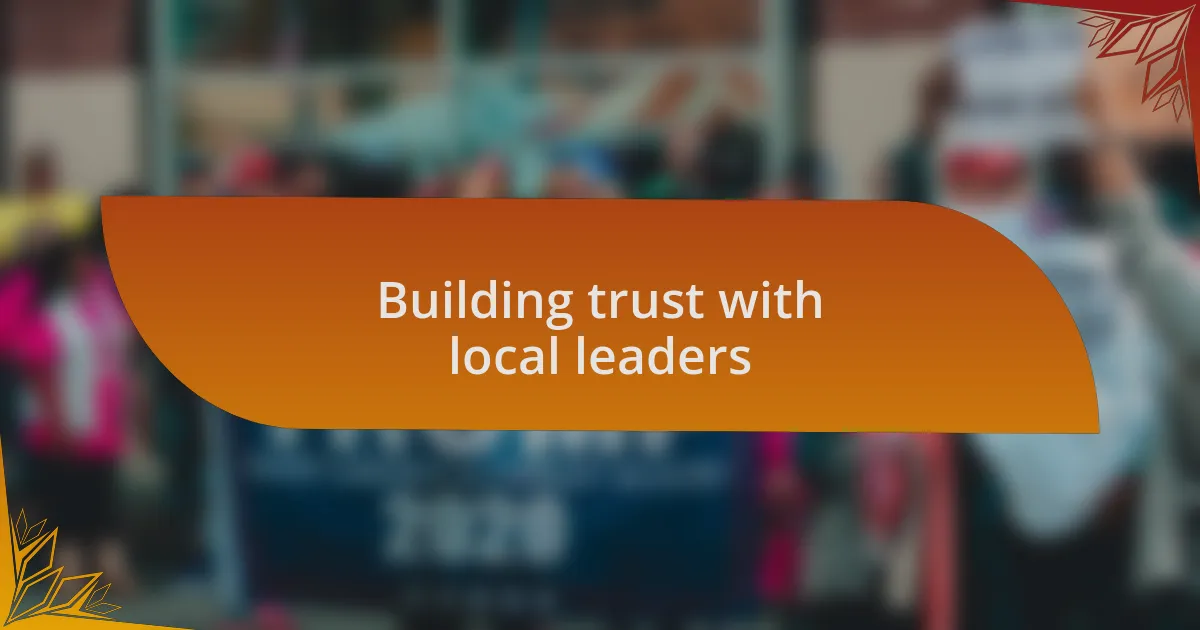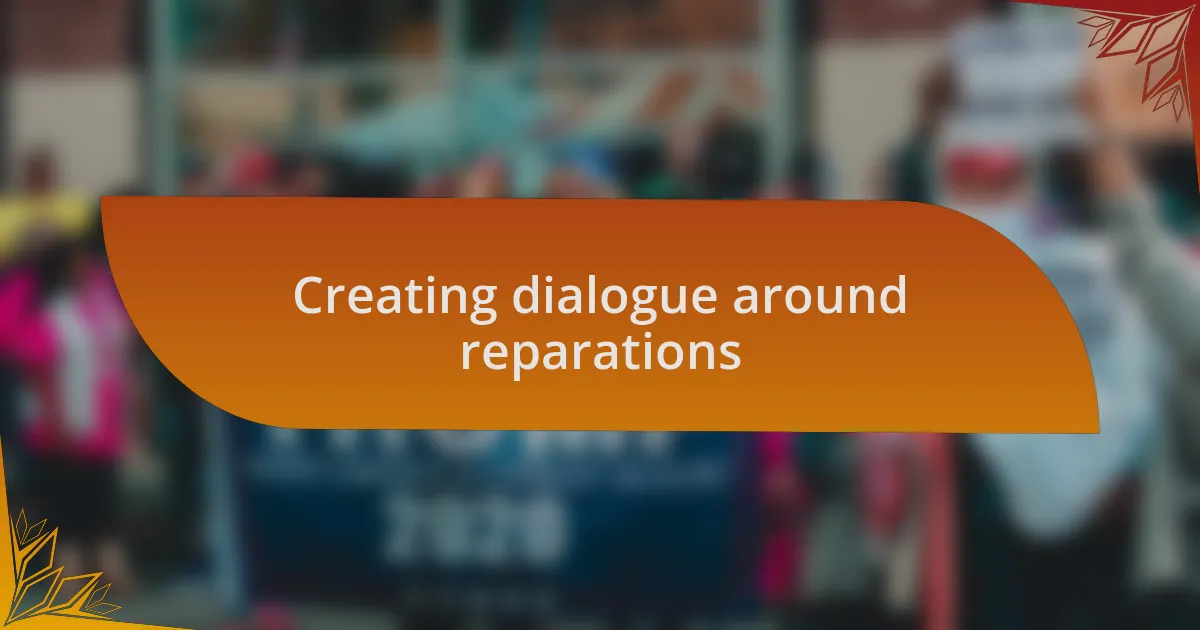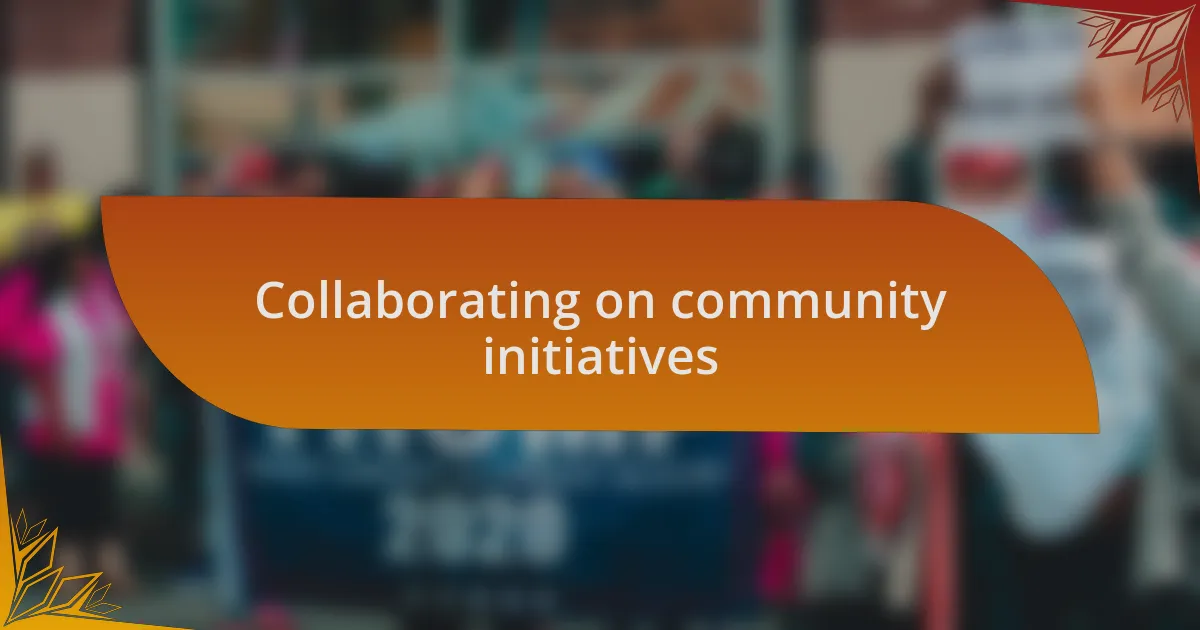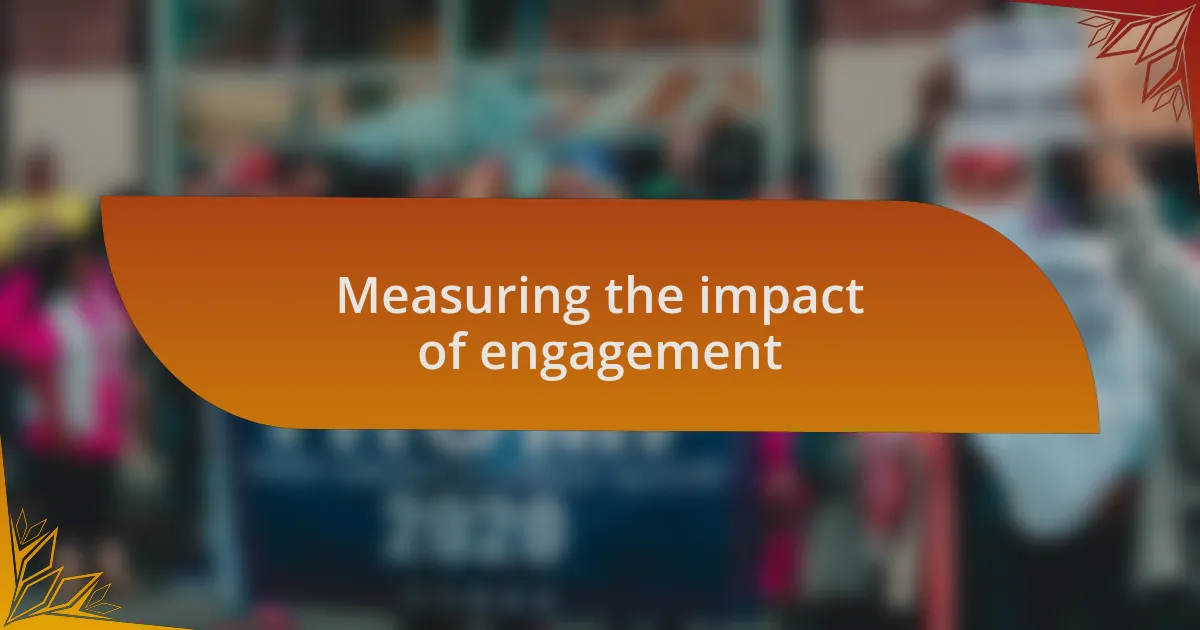Key takeaways:
- Local leadership is crucial in the reparations movement, as they connect historical injustices to current community needs and mobilize voices effectively.
- Building trust with local leaders involves consistent communication, active listening, and transparency, which fosters engagement in difficult discussions.
- Creating dialogue around reparations is enhanced by personal storytelling and safe spaces for discussion, leading to a deeper emotional connection to the issues.
- Collaborative community initiatives not only educate but also foster unity, demonstrating how small collective actions can drive meaningful conversations about reparations.

Understanding reparations politics
Reparations politics is a nuanced and often contentious area of discussion, rooted deeply in historical injustices. I recall a community meeting where a local leader shared how his family lineage has been affected by systemic inequalities, fostering a deeper understanding of how these issues are not just abstract concepts. How could we ignore the pain and lost opportunities generations have faced?
The dialogue around reparations often raises questions about fairness and responsibility. I remember sitting in a workshop where participants expressed frustration that many in power seemed detached from the realities of those impacted by historic injustices. Isn’t it crucial that we address these disparities with tangible policies that not only acknowledge the past but also respond to the present needs?
As conversations about reparations evolve, they invite broader discussions on social justice and equity. I often think about the role that local leaders play in shaping these dialogues. Are they truly representing the voices of the communities they serve, or are they simply paying lip service to an urgent issue? I believe that genuine engagement is essential for fostering meaningful change.

Importance of local leadership
Local leadership plays a pivotal role in the reparations movement because they often have intimate knowledge of the community’s unique history and struggles. I remember a local councilor passionately recounted how their neighborhood was once vibrant with promise but has since suffered from disinvestment and neglect. It made me realize that effective advocates can bridge the gap between policy discussions and the real lived experiences of their constituents.
In many instances, these leaders are the ones who can mobilize community voices, ensuring that those most affected by historical injustices are heard in conversations about reparations. I once attended a town hall meeting where a local activist urged participants to share their stories, turning a passive session into an inspiring call to action. How can we expect meaningful progress if the people at the forefront of change are not truly engaged?
Moreover, local leaders can create a moral imperative for reparative measures by connecting the dots between the past and the present. A few years ago, I witnessed a local leader introduce a reparations agenda that invited honest conversations about historical harms and their contemporary impacts—like the effects of redlining. This reminded me that reparations isn’t just a political issue; it’s about healing a community’s wounds through collective acknowledgment and action.

Strategies for engaging leaders
Engaging local leaders requires building authentic relationships based on trust and shared vision. I recall a moment when I approached a community leader at a local park event, genuinely interested in their thoughts on historical injustices. That simple conversation opened the door for future collaborations, highlighting how informal settings can foster deeper connections and spark meaningful dialogues.
It’s essential to leverage local gatherings to create platforms for discussion. I remember an inspiring workshop where leaders and community members sat together, sharing their narratives. This approach not only amplified their voices but also reinforced the importance of collective storytelling, as it fostered empathy and understanding among participants.
Lastly, I believe in the power of education. Providing local leaders with tailored resources and training on reparative justice can deepen their engagement. For example, I once organized a small seminar for leaders, equipping them with data and narratives from the reparations movement. This empowered them to advocate more effectively within their communities, transforming them into passionate champions for change.

Building trust with local leaders
Building trust with local leaders is often about consistency and reliability in communication. I once worked alongside a city council member who was skeptical about reparations discussions. Instead of pushing an agenda, I regularly shared relevant articles and research findings with them, fostering a dialogue that gradually built rapport. When leaders see that you’re committed to ongoing conversations rather than one-off interactions, it cultivates a deeper level of trust.
Another effective strategy is active listening. I recall attending a community meeting where a leader passionately expressed concerns about how reparations discussions might divide rather than unite. Rather than dismissing these fears, I genuinely listened and acknowledged their perspective, which transformed the atmosphere of the conversation. It made me realize that validating their feelings was crucial in building trust and showcasing that I valued their input.
Moreover, transparency can build strong foundations of trust. One time, I hosted an open forum where local leaders could see the financial and social implications of reparative initiatives. By being open about statistics, potential outcomes, and challenges, the leaders felt more confident in discussing these issues. It’s remarkable how transparency can turn skepticism into collaboration, don’t you think? When leaders feel informed, they are more inclined to engage actively and advocate for meaningful change.

Creating dialogue around reparations
Creating dialogue around reparations requires an openness to various perspectives. I remember a roundtable discussion where I invited local business owners to express their thoughts on reparations. Some were apprehensive, fearing potential backlash or misunderstanding. By creating a safe space for them to share, I saw how dialogue not only eased their concerns but also sparked genuine curiosity about reparations’ broader societal impacts. Isn’t it fascinating how conversation can bridge gaps and open minds?
Another important aspect is sharing personal stories. I’ve often shared the experiences of families impacted by historical injustices during these discussions. One memory that sticks out is when a local leader openly wept hearing a grandmother’s story about her family’s struggles. That moment underscored how personal narratives humanize the issue, making it more relatable and urgent. I believe that when we connect emotionally, it drives us to want to be part of the solution.
Building dialogue isn’t just about exchanging ideas; it’s about cultivating a sense of community around the topic. I recall a community potluck where reparations were informally discussed among neighbors, leading to great conversations while sharing meals. This relaxed environment encouraged participants to express their views honestly. It’s moments like these that remind me: when we weave reparations discussions into the fabric of everyday life, we foster a community that is not just aware but invested in the conversation. Doesn’t that resonate?

Collaborating on community initiatives
Collaborating on community initiatives can amplify the impact of reparations discussions. I remember joining forces with a local arts collective to create a mural that depicted the history of our community and its struggles. As artists painted and residents gathered, we saw how collaborating in this way not only beautified our surroundings but also ignited conversations about our past and the need for reparations. Isn’t it incredible how creativity can inspire dialogue?
I find that when community leaders work together towards shared goals, it can foster a sense of unity. In one initiative, our neighborhood organized a clean-up day that also served as an educational event about reparative justice. The smiles on participants’ faces while planting trees made me realize that actionable efforts, combined with education, can plant the seeds for deeper understanding of reparations. Have you ever seen how small actions lead to meaningful discussions?
Sometimes, it’s the collaborative projects that evolve organically that surprise me the most. After launching a series of workshops on community history, I was approached by a local school to include reparations education in their curriculum. The partnership blossomed, resulting in students presenting their findings to the community. Witnessing young minds engage with such complex issues is a powerful reminder of the potential we have when we come together. How often do we underestimate the influence of collaboration?

Measuring the impact of engagement
Measuring the impact of engagement can sometimes feel like piecing together a puzzle. During a recent campaign, we tracked changes in community sentiment through surveys before and after our events. The boost in awareness about reparations was tangible; people were not just participating; they were engaging in discussions, asking questions, and sharing insights. Isn’t it fascinating how numbers can tell a story of transformation?
I remember a particularly powerful moment when we organized a town hall meeting to discuss reparative justice. Afterward, I noticed a significant increase in social media discussions around the topic, indicating that the conversation had seeped beyond our gathering. It made me reflect on the ripple effect of dialogue – when we spark curiosity and understanding, it often travels far beyond the initial space. How many stories of change are waiting to unfold from our conversations?
Observing the shift in community dynamics is another crucial metric for measuring engagement. After a series of collaborative storytelling sessions, attendees expressed not only a deeper connection to their heritage but also a desire to initiate local reparations dialogues. One woman shared that she felt empowered for the first time to advocate for her community’s needs. It was a revelatory moment for me, highlighting that the true impact lies not just in participation, but in igniting personal advocacy and empowerment. Have you felt that shift when voices unite for a common cause?